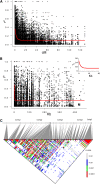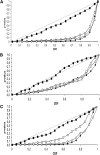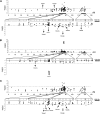Genome-wide association mapping in tomato (Solanum lycopersicum) is possible using genome admixture of Solanum lycopersicum var. cerasiforme
- PMID: 22908034
- PMCID: PMC3411241
- DOI: 10.1534/g3.112.002667
Genome-wide association mapping in tomato (Solanum lycopersicum) is possible using genome admixture of Solanum lycopersicum var. cerasiforme
Abstract
Genome-wide association mapping is an efficient way to identify quantitative trait loci controlling the variation of phenotypes, but the approach suffers severe limitations when one is studying inbred crops like cultivated tomato (Solanum lycopersicum). Such crops exhibit low rates of molecular polymorphism and high linkage disequilibrium, which reduces mapping resolution. The cherry type tomato (S. lycopersicum var. cerasiforme) genome has been described as an admixture between the cultivated tomato and its wild ancestor, S. pimpinellifolium. We have thus taken advantage of the properties of this admixture to improve the resolution of association mapping in tomato. As a proof of concept, we sequenced 81 DNA fragments distributed on chromosome 2 at different distances in a core collection of 90 tomato accessions, including mostly cherry type tomato accessions. The 81 Sequence Tag Sites revealed 352 SNPs and indels. Molecular diversity was greatest for S. pimpinellifolium accessions, intermediate for S. l. cerasiforme accessions, and lowest for the cultivated group. We assessed the structure of molecular polymorphism and the extent of linkage disequilibrium over genetic and physical distances. Linkage disequilibrium decreased under r(2) = 0.3 within 1 cM, and minimal estimated value (r(2) = 0.13) was reached within 20 kb over the physical regions studied. Associations between polymorphisms and fruit weight, locule number, and soluble solid content were detected. Several candidate genes and quantitative trait loci previously identified were validated and new associations detected. This study shows the advantages of using a collection of S. l. cerasiforme accessions to overcome the low resolution of association mapping in tomato.
Keywords: admixture; association mapping; linkage disequilibrium; tomato (Solanum lycopersicum).
Figures






Similar articles
-
Phenotypic diversity and association mapping for fruit quality traits in cultivated tomato and related species.Theor Appl Genet. 2013 Mar;126(3):567-81. doi: 10.1007/s00122-012-2002-8. Epub 2012 Nov 4. Theor Appl Genet. 2013. PMID: 23124430
-
Variation revealed by SNP genotyping and morphology provides insight into the origin of the tomato.PLoS One. 2012;7(10):e48198. doi: 10.1371/journal.pone.0048198. Epub 2012 Oct 31. PLoS One. 2012. PMID: 23118951 Free PMC article.
-
A clarified position for Solanum lycopersicum var. cerasiforme in the evolutionary history of tomatoes (solanaceae).BMC Plant Biol. 2008 Dec 20;8:130. doi: 10.1186/1471-2229-8-130. BMC Plant Biol. 2008. PMID: 19099601 Free PMC article.
-
Trait discovery and editing in tomato.Plant J. 2019 Jan;97(1):73-90. doi: 10.1111/tpj.14152. Epub 2018 Dec 24. Plant J. 2019. PMID: 30417464 Review.
-
The genetic basis of fruit morphology in horticultural crops: lessons from tomato and melon.J Exp Bot. 2014 Aug;65(16):4625-37. doi: 10.1093/jxb/eru017. Epub 2014 Feb 11. J Exp Bot. 2014. PMID: 24520021 Review.
Cited by
-
Local ancestry corrects for population structure in Saccharomyces cerevisiae genome-wide association studies.Genetics. 2012 Dec;192(4):1503-11. doi: 10.1534/genetics.112.144790. Epub 2012 Sep 28. Genetics. 2012. PMID: 23023004 Free PMC article.
-
Genome-wide association studies using single nucleotide polymorphism markers developed by re-sequencing of the genomes of cultivated tomato.DNA Res. 2013 Dec;20(6):593-603. doi: 10.1093/dnares/dst033. Epub 2013 Jul 31. DNA Res. 2013. PMID: 23903436 Free PMC article.
-
Crop plants as models for understanding plant adaptation and diversification.Front Plant Sci. 2013 Aug 1;4:290. doi: 10.3389/fpls.2013.00290. eCollection 2013. Front Plant Sci. 2013. PMID: 23914199 Free PMC article.
-
Bayesian QTL mapping using genome-wide SSR markers and segregating population derived from a cross of two commercial F1 hybrids of tomato.Theor Appl Genet. 2017 Aug;130(8):1601-1616. doi: 10.1007/s00122-017-2913-5. Epub 2017 May 5. Theor Appl Genet. 2017. PMID: 28477044
-
Genomic and Phenotypic Diversity of Cultivated and Wild Tomatoes with Varying Levels of Heat Tolerance.Genes (Basel). 2021 Mar 29;12(4):503. doi: 10.3390/genes12040503. Genes (Basel). 2021. PMID: 33805499 Free PMC article.
References
-
- Ardlie K. G., Kruglyak L., Seielstad M., 2002. Patterns of linkage disequilibrium in the human genome. Nat. Rev. Genet. 3: 299–309 - PubMed
-
- Benjamini Y., Hochberg Y., 2000. On the adaptive control of the false discovery rate in multiple testing with independent statistics. J. Educ. Behav. Stat. 25: 60–83
-
- Bradbury P. J., Zhang Z., Kroon D. E., Casstevens T. M., Ramdoss Y., et al. , 2007. TASSEL: software for association mapping of complex traits in diverse samples. Bioinformatics 23: 2633–2635 - PubMed
-
- Buckler I., Edward S., Thornsberry J. M., 2002. Plant molecular diversity and applications to genomics. Curr. Opin. Plant Biol. 5: 107–111 - PubMed
Publication types
MeSH terms
LinkOut - more resources
Full Text Sources
Research Materials
